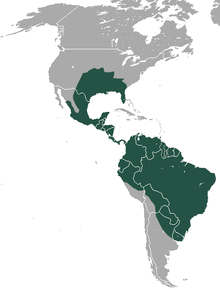Dasypus novemcinctus
| Nine-banded armadillo | |
|---|---|
 |
|
| Scientific classification | |
| Kingdom: | Animalia |
| Phylum: | Chordata |
| Class: | Mammalia |
| Order: | Cingulata |
| Family: | Dasypodidae |
| Genus: | Dasypus |
| Species: | D. novemcinctus |
| Binomial name | |
|
Dasypus novemcinctus Linnaeus, 1758 |
|
 |
|
| Nine-banded armadillo range | |
The nine-banded armadillo (Dasypus novemcinctus), or the nine-banded, long-nosed armadillo, is a medium-sized mammal found in North, Central, and South America, making it the most widespread of the armadillos. Its ancestors originated in South America, and remained there until the formation of the Isthmus of Panama allowed them to enter North America as part of the Great American Interchange. The nine-banded armadillo is a solitary, mainly nocturnal animal, found in many kinds of habitats, from mature and secondary rainforests to grassland and dry scrub. It is an insectivore, feeding chiefly on ants, termites, and other small invertebrates. The armadillo can jump 3–4 ft (91–122 cm) straight in the air if sufficiently frightened, making it a particular danger on roads. It is the state small mammal of Texas.
The nine-banded armadillo evolved in a warm, rainy environment, and is still most commonly found in regions resembling its ancestral home. As a very adaptable animal, though, it can also be found in scrublands, open prairies, and tropical rainforests. It cannot thrive in particularly cold or dry environments, as its large surface area, which is not well insulated by fat, makes it especially susceptible to heat and water loss.
The nine-banded armadillo has been rapidly expanding its range both north and east within the United States, where it is the only regularly occurring species of armadillo. The armadillo crossed the Rio Grande from Mexico in the late 19th century, and was introduced in Florida at about the same time by humans. By 1995, the species had become well established in Texas, Oklahoma, Louisiana, Arkansas, Mississippi, Alabama, and Florida, and had been sighted as far afield as Kansas, Missouri, Tennessee, Georgia and South Carolina. A decade later, the armadillo had become established in all of those areas and continued its migration, being sighted as far north as southern Nebraska, southern Illinois, and southern Indiana. The primary cause of this rapid expansion is explained simply by the species having few natural predators within the United States, little desire on the part of Americans to hunt or eat the armadillo, and the animals' high reproductive rate. The northern expansion of the armadillo is expected to continue until the species reaches as far north as Ohio, Pennsylvania, New Jersey and Connecticut, and all points southward on the East Coast of the United States. Further northward and westward expansion will probably be limited by the armadillo's poor tolerance of harsh winters, due to its lack of insulating fat and its inability to hibernate. As of 2009, newspaper reports indicated the nine-banded armadillo seems to have expanded its range northward as far as Omaha, Nebraska in the west, and Kentucky Dam and Evansville, Indiana, in the east. In 1995, armadillos were only seen in the southern tip of South Carolina, and within two to three years, they had swept across most of the state. In late 2009, North Carolina began considering the establishment of a hunting season for armadillo, following reports that the species has been moving into the southern reaches of the state (roughly between the areas of Charlotte and Wilmington). Outside the United States, the nine-banded armadillo ranges southward through Central and South America into northern Argentina and Uruguay, where it is still expanding its range.
...
Wikipedia

